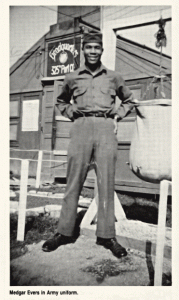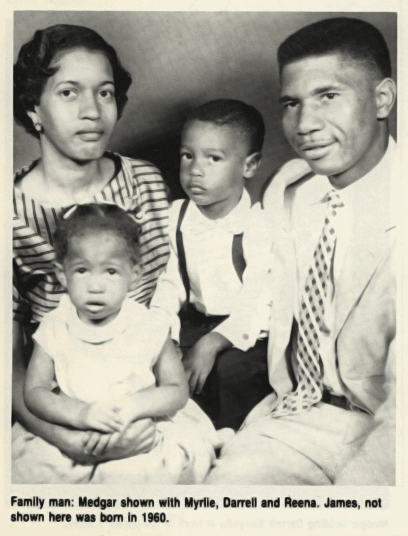Medgar Wiley Evers is a civil rights campaigner and field secretary for the National Association for the Advancement of Colored People (NAACP) whose murder in 1963 prompted President John F. Kennedy to ask Congress for a comprehensive civil rights bill. Evers became the first martyr to the 1960s civil rights movement, and his death was a turning point for many in the struggle for equality, infusing other civil rights leaders with renewed determination to continue their struggle despite the violent threats being made against them. In the wake of Evers’s assassination, a new civil rights motto was born.
—”After Medgar, no more fear.”
Medgar Wiley Evers was born in 1925 in Decatur, Mississippi, to James and Jessie Evers. During his childhood in Decatur, Evers encountered overt racism on a daily basis. When he was twelve years old, a family friend was lynched, and the man’s bloody clothing hung on a fence for more than a year as a sign of intimidation. While in his teens, Evers watched from a safe distance as white gangs patrolled the streets of Decatur on Saturday nights looking for a black target to beat up or run down with their cars.

Evers was determined to make something of himself, despite the hatred of local white people. After dropping out of high school at seventeen, he joined the army and soon found himself fighting on Europe’s battlefields during World War II. (1)
After his sophomore year in high school, Medgar followed [his brother] Charles into the Army during World War II. He was assigned to a segregated field battalion in England and France.
Although some black soldiers refused to come back from France where they were treated as equals, some vowed to return fighting. As Medgar said to his brother after a racial incident, “When we get out of the Army, we’re going to straighten this thing out!” (2)
In 1946, after three years of distinguished military service, Evers received an honorable discharge, finished high school, and enrolled in Alcorn College in Mississippi (now Alcorn State University), where he majored in business administration. There he met Myrlie Beasley, whom he married on December 24, 1951.
After receiving his Bachelor of Arts degree, Evers and his wife moved to Mound Bayou, Mississippi, where he took a job selling insurance. Alarmed at the level of poverty and destitution he found among the black populace of rural Mississippi, Evers decided to do something about it and joined the NAACP.
Evers soon began organizing local NAACP chapters and coordinating boycotts of gasoline stations that refused to allow African Americans to use their restrooms. Evers’s organizational skills allowed him to bring together isolated groups of disillusioned individuals and meld them into a unified force.

Following the landmark Supreme Court ruling, Brown v. Board of Education (1954), which outlawed segregation in public schools, Evers applied for admission to the University of Mississippi Law School, but his application was denied. This action brought Evers to the attention of the NAACP national leadership, and he was appointed Mississippi’s first field secretary for the organization that same year.
Moving to Jackson, Mississippi, in 1954, Evers worked to set up an NAACP office there. In the early 1960s, he organized high-profile boycotts of merchants in Jackson. In 1962, he played an instrumental role in the campaign to have African American student James Meredith admitted to the University of Mississippi. (1)
Myrlie was to become deeply involved in Medgar’s work in the Civil Rights Movement. She served as his full-time secretary in the Jackson NAACP office. And she made valuable contributions to the Civil Rights Movement in her own right as a helpmate, researcher for speeches, hostess, chauffeur, and musician. (2)
By this time, threats on his life were a regular occurrence, with the Eversname featured prominently on many white supremacist death lists. Nevertheless, Evers remained completely absorbed in the struggle for freedom. His workday often lasted up to twenty hours, consisting of organizing boycotts, marches, prayer vigils, and bailing out those who had been arrested.
In early 1963, the Evers home was firebombed. A few weeks later, on June 12, 1963, President John F. Kennedy addressed the nation, calling white resistance to civil rights a “moral crisis” and pledging federal support for integration. While President Kennedy’s address was being broadcast across America, Evers was attending an NAACP function. Returning home just after midnight that same day, he was struck by a sniper’s bullet and lay in a pool of blood on the doorstep of his home. Fifty minutes later, Medgar Evers was dead.
A tide of anger surged through the African American community in response to Evers’s death. The Federal Bureau of Investigation (FBI) undertook an investigation of the case and soon came up with a suspect, white supremacist Byron de la Beckwith, whose fingerprints were found on a gun at the murder scene. De la Beckwith was tried by all-white juries twice in the mid-1960s, and both times jurors failed to convict him. It took thirty years for de la Beckwith to be brought to trial a third time. On February 5, 1994, a racially mixed jury found him guilty of the murder of Medgar Evers. Sentenced to life imprisonment, De la Beckwith died of heart failure in 2001.
In 1963, the NAACP posthumously awarded Medgar Evers the Spingarn Medal for services to the African American community. His widow, Myrlie Evers, vowed to continue the fight for civil rights, and she has traveled the world to bring the struggle to an international audience.
Between 1995 and 1998, Myrlie Evers served as chair of the National Board of Directors of the NAACP. Medgar’s brother, Charles Evers, replaced him as NAACP field secretary and eventually became mayor of Fayette, Mississippi. In 1970, Medgar Evers College of the City University of New York was founded in Brooklyn, New York (1)
(1) “Evers, Medgar Wylie (1925–1963).” Encyclopedia of African American Society. Ed. Gerald D. Jaynes. Vol. 1. Thousand Oaks, CA: SAGE Reference, 2005. 299-300. Gale Virtual Reference Library
(2) Bailey, Ronald W. Remembering Medgar Evers … for a New Generation. Oxford, Miss.: Distributed by Heritage Publications in cooperation with the Mississippi Network for Black History and Heritage, 1988.